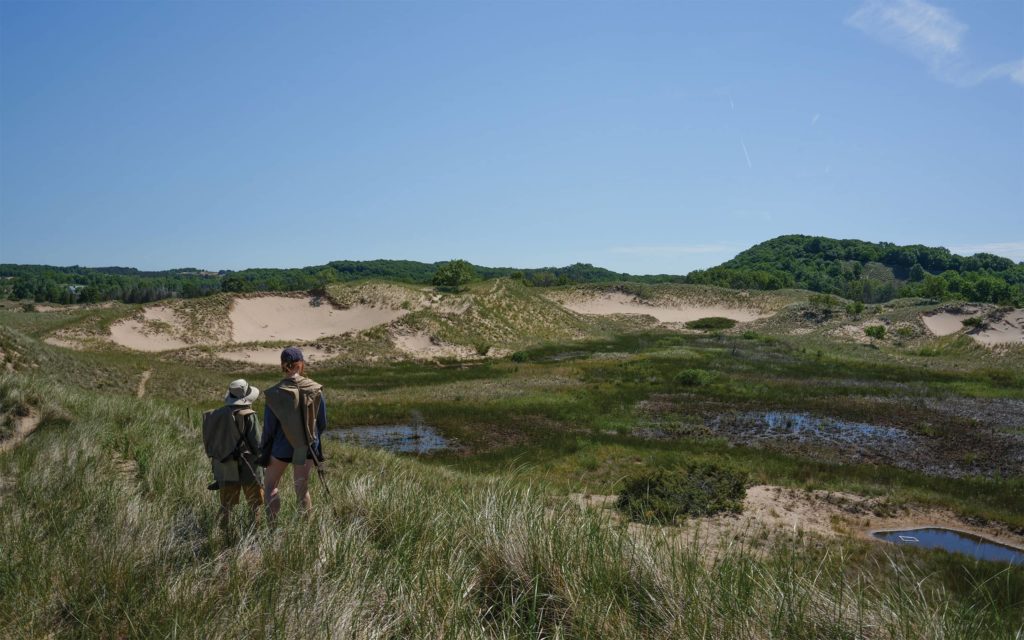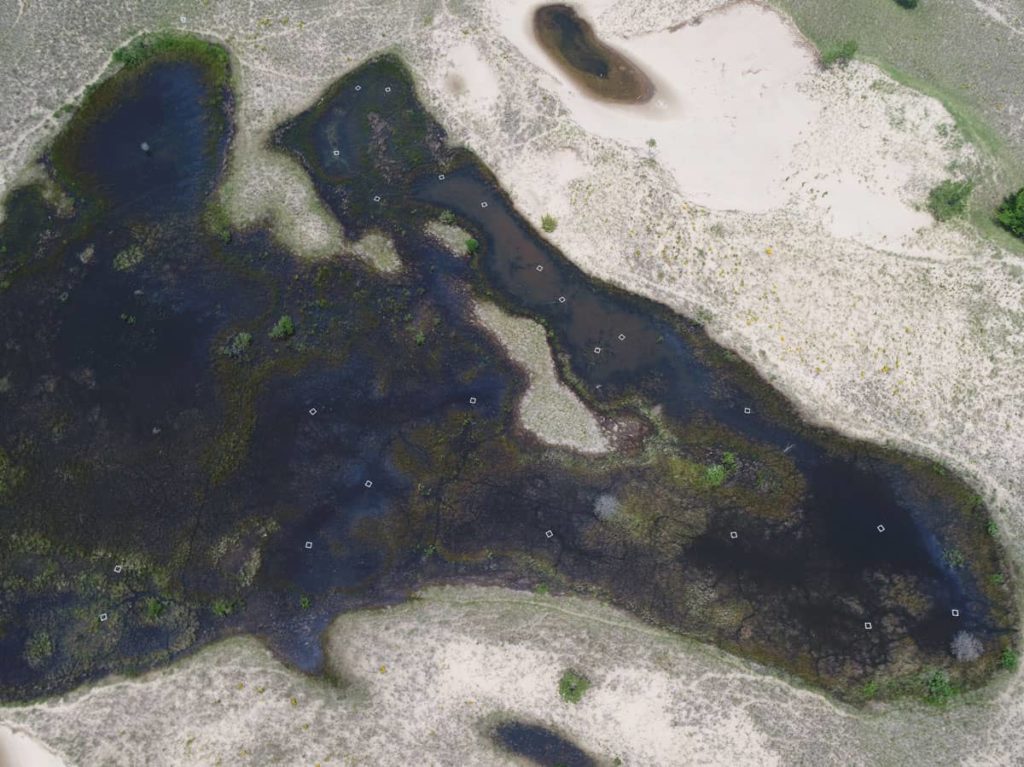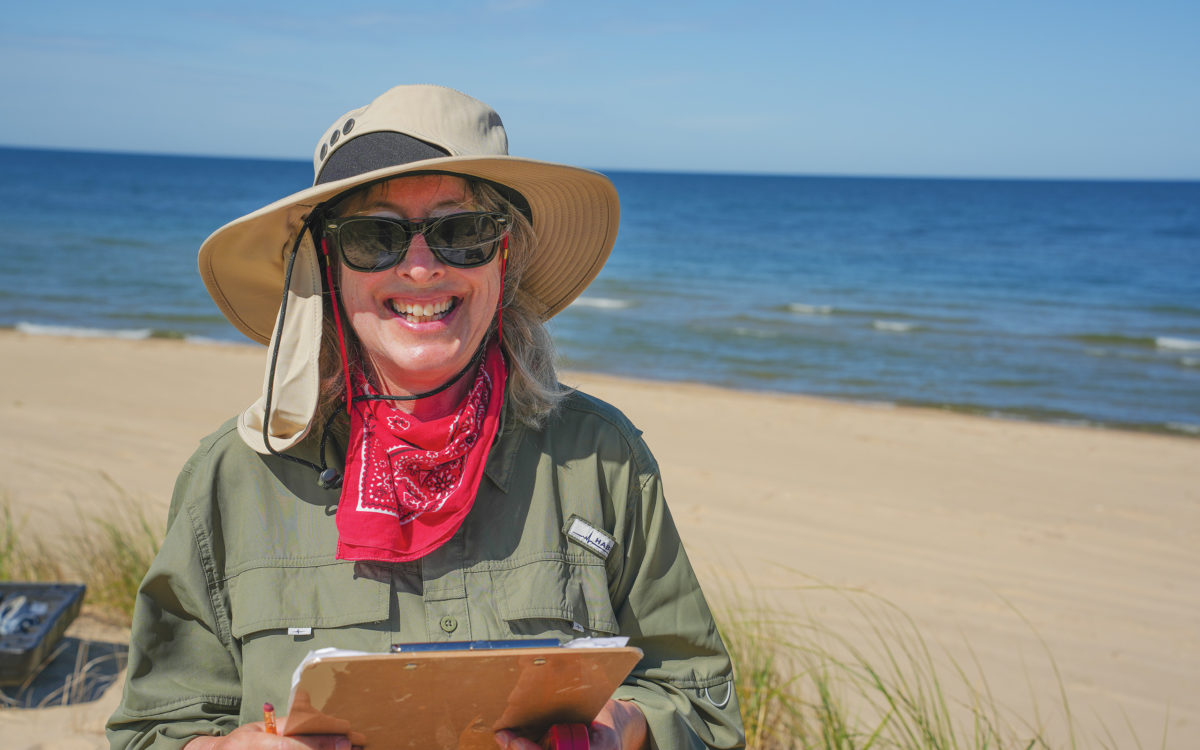Why Do Wetlands Come and Go Between Dunes?
A long-running Hope study uncovers answers — and more questions
Professor Suzanne DeVries-Zimmerman ’82
“On Sunday afternoons, after church and dinner, one of my favorite places to go was the area that’s now called the Saugatuck Harbor Natural Area,” said Professor Suzanne DeVries-Zimmerman ’82, a West Michigan native and assistant professor of geological and environmental science instruction. “I just thought the whole area was fascinating — these wetlands in the midst of the dry dunes. And I just remember thinking to myself: Gee, when I grow up, I would love to study these.”

“Well,” she added, laughing, “I’m 5 foot 4; I never really grew up.” But she did come to study the dunes, and eventually the interdunal wetlands, which had transitioned to upland dune vegetation when Lake Michigan’s water level was low from 1998 to 2014 (a change that for years caused her colleagues in the Department of Geology and Environmental Sciences to be skeptical of DeVries-Zimmerman’s childhood memories).
Then in 2016 — just three years after Lake Michigan’s lowest recorded water levels — the interdunal wetlands reappeared in Saugatuck Harbor Natural Area, heralded by frog songs. DeVries-Zimmerman was thrilled, not just by the confirmation of her youthful memories but also by the return of a unique and little-studied ecosystem.
“In order to get these interdunal wetlands you have to have a low dune complex — not the really tall parabolic dunes — because you have to have the wind erode the sand so that you hit the water table,” the geologist said. Dynamism in the water level is also a given, and the wetlands have adapted a regenerative strategy to cope with cycles of scarcity and plenty.
“One thing these wetlands do is they dry out and they come back, they dry out and come back. Lake Michigan has done this up and down for decades — for years even before historical records,” DeVries-Zimmerman said. “These systems have adapted to where the seed bank can persist until water levels come up and allow that vegetation to have the right conditions to germinate, which is absolutely incredible when you think about it. Seeds have survived 25, 30 years of dormancy. But if things dry out, water levels drop, and you don’t get the influx of water to regerminate those species. Then the system disappears.”
The environment is a rare and threatened one, despite its hardy, regenerative abilities. How it will hold up in the coming decades remains an open question, but DeVries-Zimmerman and her colleagues in the interdisciplinary Hope College Coastal Group are in the midst of what may be the only research investigating the habitat from the multifaceted approach of combining water chemistry, vegetation dynamics and remote sensing.
“As far as we know, we are the only ones doing a longitudinal study like this on the wetlands within the Great Lakes basin,” DeVries-Zimmerman said. “There have been smaller snapshots, but nobody has carried on a study for this long.” Their study began in 2016 — with the return of the frogs — and is still going strong.
The six years’ worth of data has enabled DeVries-Zimmerman’s primary project this summer: running statistics on reams of data concerning vegetation, water chemistry and water level patterns to investigate the environment’s trends as each variable has ebbed and flowed.
There have been surprises.
“We thought that as the water levels dropped, we would see the bulk of the vegetation density come back, except we didn’t plan on the muskrats moving in,” DeVries-Zimmerman explained. After a year of their voracious munching, it remains to be seen how the vegetation coverage will ultimately respond: “Now we have an additional complicating factor, to see how those seeds come back after just being plundered and eaten and all those roots just chewed to bits.” That unpredictability highlights the value of a longitudinal study in such a dynamic environment where not everything is as it might seem.
The interdisciplinary nature of the group’s work lets the professors involved paint a remarkably robust picture of these variable environs and introduce their students to a variety of research strategies and tools.

“The dunes, I think, are the primary example: It’s not just geology; it’s not just the wind and sand moving. The plants are an integral part of what’s happening. And certainly within the wetlands, the whole hydrogeology is definitely a part of it, and the chemistry of that water. It all plays together,” DeVries-Zimmerman said. “We’re able to integrate our research and give the students a wider research experience. They get a better experience because they haven’t just been siloed into one discipline.”
Mentoring student researchers is a substantial and meaningful piece of DeVries-Zimmerman’s work — and the Coastal Research Group’s as a whole. She’s particularly valued the opportunity to help young women to see themselves in careers engaged with science, an area in which the gender is underrepresented — and has been especially gratified when they’ve also caught her passion for the dune ecosystem. “I’ve had many female researchers, and they have been in love with the wetlands project — really felt a big connection to it,” DeVries-Zimmerman related. “And with two of them, it influenced what they’re doing with grad school and with law school. So I kind of feel like a very proud mother hen.”
It is little wonder students are enthralled with the dunes; DeVries-Zimmerman’s enthusiasm for them is infectious.
“I feel incredibly lucky to be able to do research in this area that I’ve always loved since I was a kid. Not everybody gets to do that,” DeVries-Zimmerman said. “It’s my happy place. Especially during the pandemic, it has been a happy place to go and see sandhill cranes. Their call — it’s like nothing else on this planet: You can almost picture their ancestral dinosaurs.”
The dunes, changeable as they are, evoke something prehistoric, too: composed of sand that, millennia and miles away, was once sundry stones, hosting seed banks whose dormancy periods are still the stuff of conjecture. The Saugatuck Harbor Natural Area holds uncounted questions for the next generations of intrepid researchers.
“Now we need to regroup and figure out the next set of questions to ask,” DeVries-Zimmerman said. “How are we now going to go after answering those questions — knowing full well that we’ll never answer everything?”
The Hope College Coastal Group
includes Dr. Ed Hansen (emeritus), Dr. Brian Bodenbender and Professor Suzanne DeVries-Zimmerman ’82 of the Department of Geological and Environmental Sciences (GES); Dr. Michael Philben of the GES and Chemistry Departments; and Dr. Brian Yurk and Dr. Darin Stephenson of the Department of Mathematics and Statistics. Current projects include:
- Investigating the impact of changing lake levels on sand dunes and dune plant populations along the Lake Michigan shoreline
- Understanding how vegetation populations in the dunes change over time and the factors driving those changes
- Developing a variety of techniques to monitor sand movement and surface change in local dune complexes. This work is supported in part by the Curtis A. Jacobs Mathematics and Statistics Summer Research Fund and the Jobe and Julie Morrison Family Faculty Development Fund.
- Assessing the rates of carbon sequestration and greenhouse gas emissions from interdunal wetlands
- Studying historical meteorological data along the coast to evaluate regional climate change and its implications for coastal dune systems

